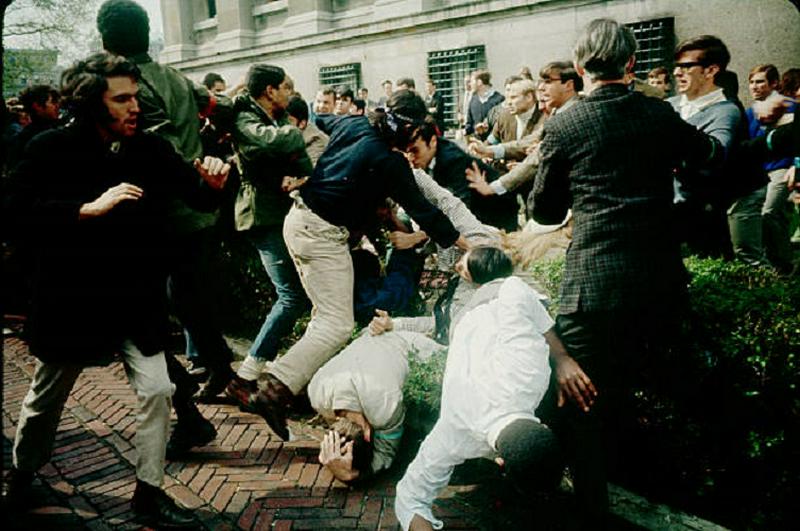When Columbia Students Held Their Dean Hostage
By | February 4, 2022

In 1968, Columbia University was embroiled in controversy; students arranged a protest because the school was stealing land and resources from Harlem. The university is located in Morningside Heights, a neighborhood on the edge of West Harlem. They proposed to build a gym in Morningside Park, on land owned by New York City. The problem was that only 12 percent of the gym would be open to the public, despite its location on public land. The remainder of the gym was designated for use by the university.
The plan helped to fuel community resentment, as Columbia’s expansion was at the expense of the residents of Morningside Heights, who were being pushed out of their homes. The design of the gym was also considered offensive, as Columbia students’ entrance was at the top, while the community entered at the bottom; they took to calling it the “gym crow” door. The black students in the Student Afro-American Society (SAS) brought the complaints of African Americans in Harlem to campus.

The Protest Arose From The Convergence Of Issues
This protest happened against the backdrop of increased student activism as the Vietnam War raged on. An anti-war group, Students for a Democratic Society (SDS), was increasing their demands for Columbia to end its association with the Institute for Defense Analyses (IDA), which was a research group that worked with the Department of Defense. On March 27, 1968, students held a peaceful demonstration inside the Low Library administration building. Because students violated Columbia’s ban on indoor demonstrations, six anti-war activists were placed on probation. These students were known as the “IDA 6”
The two issues came together, and students came together on April 23 for a rally in the center of campus. They were first prevented from protesting inside Low Library and then marched to the Columbia gym site to try to stop the construction. Police officers guarding the site, stopped them, arresting one protestor. From there, students marched back to campus, where they rushed into Hamilton Hall, which housed the administrative offices and a few classrooms. The SDS and SAS disagreed on the next steps in the occupation. The SDS wanted to take an administrator hostage as they were trying to bring attention to their goals, but the SAS wanted to maintain a focus on stopping the gym construction. At first, the two groups occupied separate sides of the building and had minimal contact. The black students in the SAS eventually asked the white students to leave Hamilton Hall, which they did, moving to Low Library. The protesters remained in part of Low Library, (which did not have an actual library) and three additional buildings. Only some of the protesters were Columbia students, as the protest attracted outside participants to join.

The Two Groups Split
When the SDS group made their way into Low Library, they occupied the President’s office. Henry S. Coleman, the acting dean, was not in the building but made his way in, past the protesters. They stated that he would be held hostage until their demands were met. He told them he had no intention of meeting their demands, and the protesters held him hostage in his office, using furniture to stop him from leaving. The protesters did provide him with water, and he was allowed to leave 24 hours later.
The 86 members of the SAS turned Hamilton Hall into living quarters, sleeping on the floor and setting up a food pantry. They hung portraits of Black Power leaders on the wall and began calling it the “Malcolm X Liberation College.” They welcomed African American visitors over the course of their week-long occupation.

Attempting To End The Protests
Columbia’s administration attempted to strike a deal but was dismissed. At 2:00 a.m. on April 30, around 1,000 police officers arrived on campus, heading first to Hamilton Hall; all 86 students surrendered. However, the white protesters did resist, and the officers made over 700 arrests, injuring over 100 students. This was not the end of the violence, as it continued the next day. When a student jumped from a second-story window and landed on a police officer, Frank Gucciardi’s back, his back was broken, leaving him permanently disabled. From May 17-22, the second round of protests occurred, this time protesting the suspension of the “IDA 6.” By the end of these protests, 177 more students were arrested and 51 were beaten.

The Aftermath
As a result of the protests, Columbia disaffiliated from the IDA. The occupation led to the creation of campus structures so students could be given a voice in university concerns. The university also hired additional African American faculty, admitted more African American students, and added a Black Studies program. The gym was not built, as plans for its construction were dropped in 1969.
Columbia found itself in a difficult financial position, as some alumni refused to donate to the school, and potential students chose to attend other universities. Columbia also changed its expansion efforts, moving west to the Hudson Riverside Park area.
